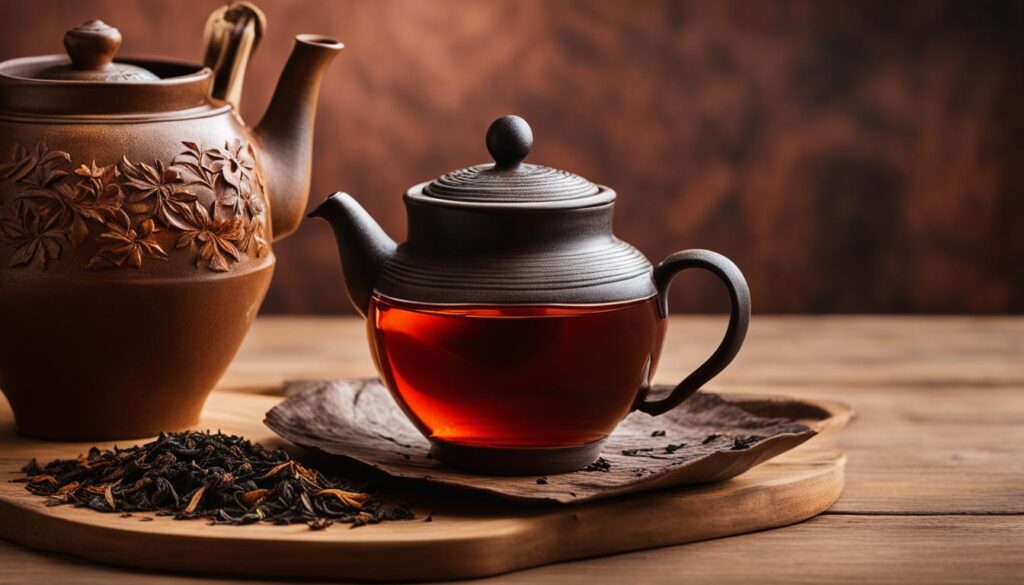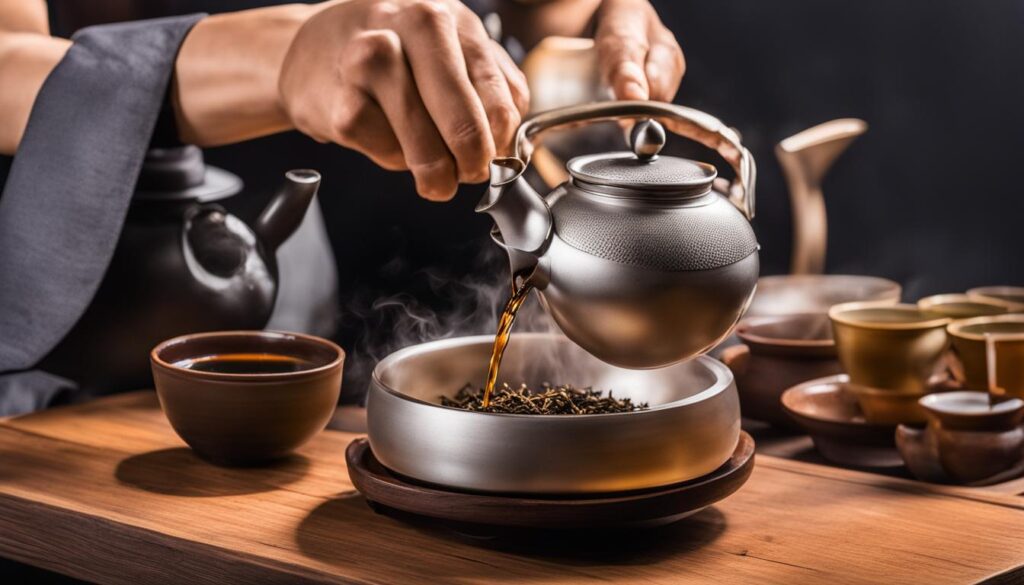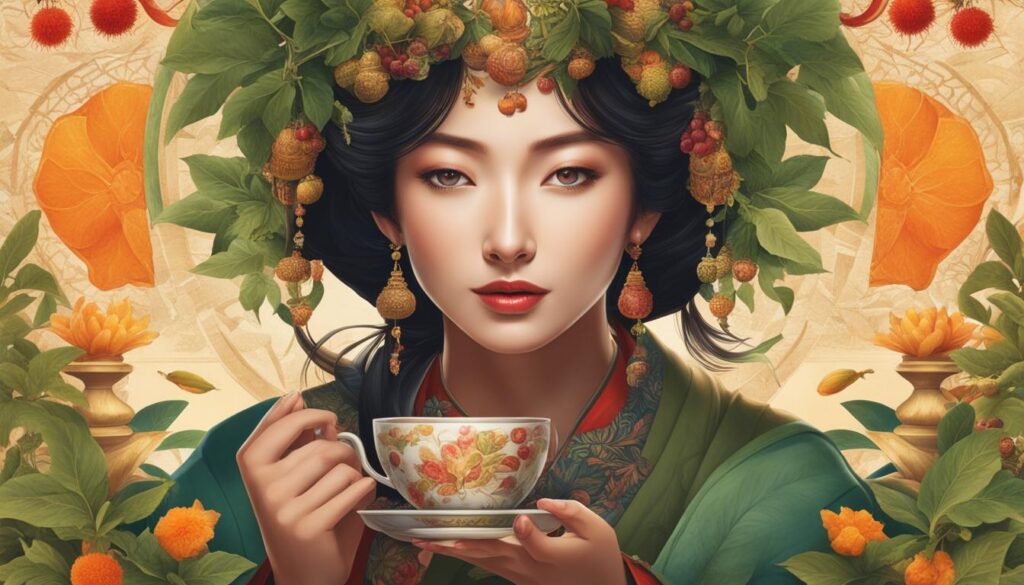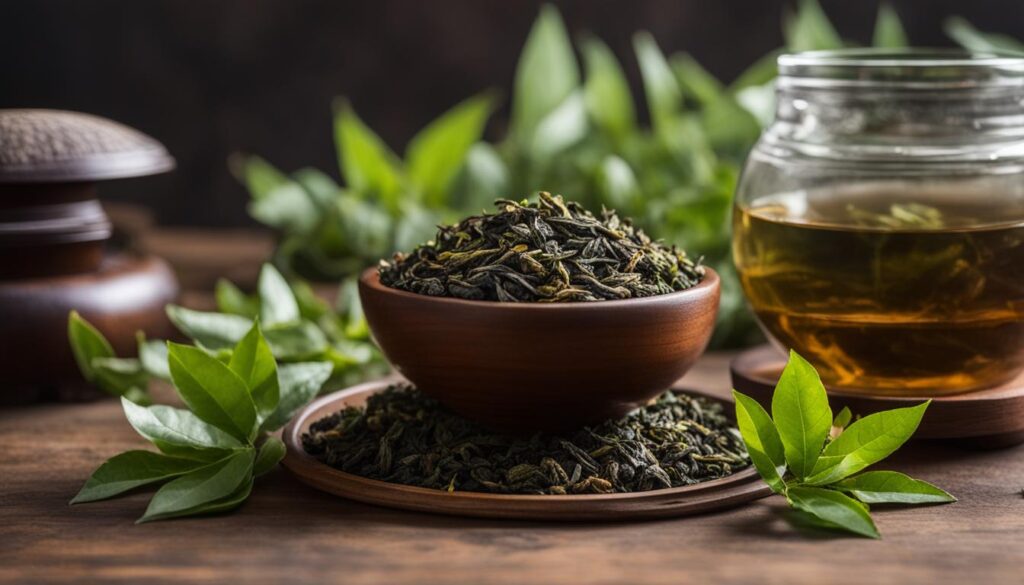As a tea enthusiast, I have always been captivated by the world of Chinese tea. One particular variety that has captured my attention is Shou tea, also known as ripe Pu-erh. This unique and flavorful tea is a fermented delight that originates from the lush tea plantations of Yunnan, China.
Shou tea, unlike its counterpart Sheng tea, undergoes fermentation before being packaged or sold. This process gives Shou tea its distinct dark color and rich flavor, akin to the characteristics of an aged Pu-erh tea. The production of Shou tea involves sun-drying, steaming, compressing, and fermenting the tea leaves in a warm and humid environment.
What sets Shou tea apart is not only its unique production process but also its myriad health benefits. It is believed to aid in digestion, promote heart health, assist in weight management, and provide antioxidants that support overall well-being. Additionally, Shou tea imparts mental clarity and can help boost the immune system.
Key Takeaways:
- Shou tea, also known as ripe Pu-erh, is a fermented tea from Yunnan, China.
- It undergoes fermentation before packaging or sale, resulting in a dark, rich flavor.
- Shou tea offers potential health benefits, including improved digestion, heart health, weight management, and immune support.
- It can be brewed using boiling water, and its flavor profile includes sweet, bitter, floral, and earthy notes.
- Shou tea is a tea variety worth exploring for tea enthusiasts and those seeking a unique and flavorful experience.
Understanding Shou Tea and Sheng Tea: What’s the Difference?
When it comes to pu-erh tea, two popular varieties are shou tea and sheng tea. While both are part of the pu-erh family, they differ in terms of their fermentation process and flavor profiles.
Shou tea, also known as fermented pu-erh, undergoes a carefully controlled fermentation process before being packaged or sold. This process involves piling the tea leaves and creating a warm and humid environment for beneficial microbes to grow. The aging process for shou tea is accelerated, resulting in a dark and rich flavor. It is typically made from large-leaf tea trees grown in the Yunnan province of China.

Sheng tea, on the other hand, is also known as raw or unfermented pu-erh. It naturally ferments over time as it matures in a cool and dry environment. Sheng tea can be made from both large-leaf and small-leaf tea trees, and its flavor profile can vary depending on the age and storage conditions. Young sheng tea tends to have a fresh and vegetal taste, while aged sheng tea develops complexity and depth of flavor, often described as woody and earthy.
The key difference between shou tea and sheng tea is the fermentation process. Shou tea is fermented before packaging or sale, while sheng tea ferments naturally over time. This difference in fermentation affects the flavor and aging process of the teas.
The Brewing Techniques for Shou Tea
To fully appreciate the rich and earthy flavors of shou tea, it’s important to master the art of brewing it correctly. Whether using a teapot or gaiwan, the brewing process remains consistent. Here’s a step-by-step guide to brewing the perfect cup of shou tea:
- Start by rinsing the tea leaves with hot water. This helps remove any impurities and prepares the leaves for brewing.
- Measure the desired amount of loose-leaf shou tea. Generally, a teaspoon of tea per cup is a good starting point, but you can adjust according to your taste preferences.
- Place the tea leaves into your teapot or gaiwan.
- Heat fresh water to a rolling boil and let it cool for a moment. Shou tea can handle boiling water, so you don’t need to worry about exact temperature control.
- Pour the hot water over the tea leaves, allowing them to steep for about 10 seconds.
- Alternatively, you can adjust the steeping time based on your preference. A shorter steeping time will result in a milder flavor, while a longer steeping time will yield a stronger brew.
- Pour the brewed tea into small cups, savoring its rich aroma and deep color.
- Take a moment to appreciate the flavors of the shou tea. It can be enjoyed on its own or with a splash of milk or sweetener if desired.
- As you explore different brewing techniques for shou tea, you may want to experience the evolving flavors in subsequent steepings. Shou tea can often be resteeped multiple times, each infusion offering a slightly different taste profile.
Mastering the brewing techniques for shou tea allows you to savor the full complexity of its flavor. As you experiment with different steeping times and adjustments, you’ll unlock new dimensions in the taste and enjoyment of this unique tea.
| Benefit | Description |
|---|---|
| Rich and Earthy Flavor | The distinctive taste profile of shou tea includes notes of earthiness, sweetness, and sometimes a hint of fruitiness. |
| Easy to Brew | Shou tea can be brewed with boiling water, making it convenient to brew at home or on-the-go. |
| Adjustable Steeping Time | You can control the strength of the tea by adjusting the steeping time according to your personal preference. |
| Multiple Infusions | Shou tea can be resteeped multiple times, providing a variety of flavors and extending the enjoyment of the tea leaves. |
| Versatile Enjoyment | Shou tea can be enjoyed on its own or paired with a splash of milk or sweetener, allowing for a versatile tea-drinking experience. |

By following these brewing techniques, you can fully appreciate the distinct flavors and aromas that shou tea has to offer. Whether you choose to use a teapot or a gaiwan, the process is straightforward and allows you to enjoy the richness of this unique tea variety.
Health Benefits of Shou Tea
Shou tea, also known as ripe pu-erh, offers a variety of health benefits that make it a valuable addition to your daily routine. Let’s take a closer look at how this fermented tea can contribute to your overall well-being.
1. Digestive Health
Shou tea contains beneficial bacteria and enzymes that can improve digestion and promote the growth of healthy gut bacteria. By maintaining a healthy digestive system, shou tea can help alleviate gastrointestinal issues and enhance nutrient absorption.
2. Heart Health
Studies have suggested that shou tea may help lower cholesterol levels and reduce the risk of heart disease. Its antioxidant properties can support cardiovascular health by preventing the oxidation of LDL cholesterol and reducing inflammation.
3. Weight Management
If you’re looking to manage your weight, shou tea can be a valuable tool. It has been found to increase metabolism and aid in reducing fat absorption, making it an excellent addition to your weight loss journey.
4. Antioxidant Properties
Shou tea contains antioxidants that are instrumental in fighting against harmful free radicals in the body. Antioxidants help protect against oxidative stress and may reduce the risk of chronic diseases, such as cancer and heart disease.
5. Mental Clarity
Shou tea has been praised for its ability to improve mental clarity and focus. The combination of caffeine and L-theanine in shou tea can provide a subtle energy boost while promoting a calm and alert state of mind.
6. Immune System Support
Supporting your immune system is crucial for overall health and well-being. Shou tea contains natural compounds that can strengthen the immune system, helping your body fight off infections and illnesses.
“Shou tea offers a range of health benefits, from promoting good digestion and heart health to supporting weight management and mental clarity.”
It’s important to note that while shou tea offers potential health benefits, more research is needed to fully understand its effects on the body. It should not be considered a substitute for medical treatment or advice.
Now that we’ve explored the health benefits of shou tea, let’s delve into the intriguing flavors and the aging process in the next section.
| Health Benefits | Description |
|---|---|
| Digestive Health | Improves digestion and promotes healthy gut bacteria |
| Heart Health | Helps reduce cholesterol levels and promotes cardiovascular health |
| Weight Management | Increases metabolism and aids in reducing fat absorption |
| Antioxidant Properties | Protects against oxidative stress and reduces the risk of chronic diseases |
| Mental Clarity | Improves focus and enhances mental clarity |
| Immune System Support | Strengthens the immune system and supports overall health |

The Flavors and Aging of Shou Tea
Shou tea, also known as ripe pu-erh, offers a diverse range of flavors that appeal to tea enthusiasts. From sweet and floral to bitter and earthy, shou tea provides a unique tasting experience.
These flavors are influenced by several factors, including terroir, the age of the tea tree, vintage, and storage conditions. Terroir refers to the composition of the soil where the tea is grown. The mineral content and characteristics of the terrain impart distinct flavors to the tea leaves.
Furthermore, the age of the tea tree plays a significant role in the flavor profile of shou tea. More mature trees produce leaves that yield a richer, more robust taste.
Vintage and storage conditions also contribute to the aging process of shou tea. Exposed to humidity and temperature fluctuations, the tea undergoes fermentation, resulting in increased complexity and depth of flavor as it ages.
As shou tea grows older, its flavor evolves, making it more sought after and often commanding higher prices.
To visualize the relationship between the factors influencing the flavors and aging of shou tea, refer to the following table:
| Factors | Impact on Flavors and Aging |
|---|---|
| Terroir | Determines the mineral content and specific characteristics of the tea |
| Age of the Tea Tree | Affects the richness and robustness of the tea |
| Vintage | Reflects the harvest year and influences the tea’s flavor development |
| Storage Conditions | Temperature and humidity impact the aging process and flavor complexity |

Exploring the Types of Pu-erh Tea
In addition to shou tea, there are two other types of pu-erh tea: young raw pu-erh and aged raw pu-erh.
Young raw pu-erh is less than five years old and resembles green tea in taste. It can be floral and sweet or bitter, with a grassy freshness.
Aged raw pu-erh, on the other hand, develops woodsy and earthy qualities over time, with dark fruit notes and a decrease in bitterness.
Ripe pu-erh, also known as shou pu-erh, undergoes a fermentation process using the wet-piling method to speed up the fermentation. It has a dark red or black liquid and can taste similar to aged raw pu-erh. Each type of pu-erh tea has its own unique characteristics and flavors, offering a wide range of options for tea enthusiasts to explore.
FAQ
What is shou tea?
Shou tea, also known as ripe pu-erh, is a fermented type of tea produced from large-leaf tea plants in Yunnan, China. It has a dark, rich flavor and is known for its health benefits.
How is shou tea different from sheng tea?
Shou tea is fermented before packaging or sale, while sheng tea ferments naturally over time. Shou tea is made from large-leaf tea trees in Yunnan, China, while sheng tea can be made from both large-leaf and small-leaf tea trees. Shou tea has a dark, rich flavor, while sheng tea can have a wide range of flavors.
What are the brewing techniques for shou tea?
To brew shou tea, you will need a teapot or gaiwan and some loose-leaf tea. Start by rinsing the tea leaves with hot water to remove any impurities. Then, steep the tea in fresh hot water for about 10 seconds. Adjust the steeping time based on your taste preferences. Pour the tea into small cups and enjoy the rich, earthy flavor of shou tea. Shou tea can be brewed with boiling water, making it easy to brew at home.
What are the health benefits of shou tea?
Shou tea contains beneficial bacteria and enzymes that can improve digestion and promote healthy gut bacteria. It may help to reduce cholesterol levels, improve heart health, aid in weight management, provide antioxidants, enhance mental clarity, and support the immune system. However, more research is needed to fully understand its effects.
What flavors can I expect from shou tea?
Shou tea offers a range of flavors, including sweet, bitter, floral, mellow, woody, astringent, sour, and earthy. These flavors are influenced by factors such as terroir, age of the tea tree, vintage, and storage conditions. Shou tea tends to develop more complexity and depth of flavor as it ages.
What are the types of pu-erh tea?
In addition to shou tea, there are two other types of pu-erh tea: young raw pu-erh and aged raw pu-erh. Young raw pu-erh resembles green tea in taste and can be floral and sweet or bitter. Aged raw pu-erh develops woodsy and earthy qualities over time, with dark fruit notes and a decrease in bitterness. Ripe pu-erh, also known as shou pu-erh, undergoes a fermentation process to speed up the fermentation and has a dark red or black liquid.